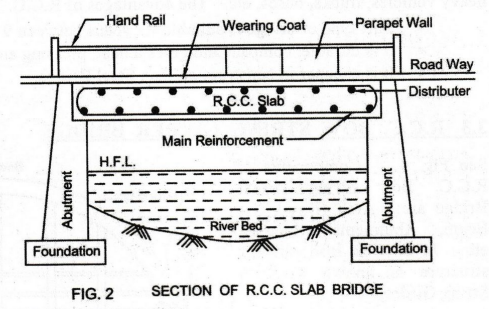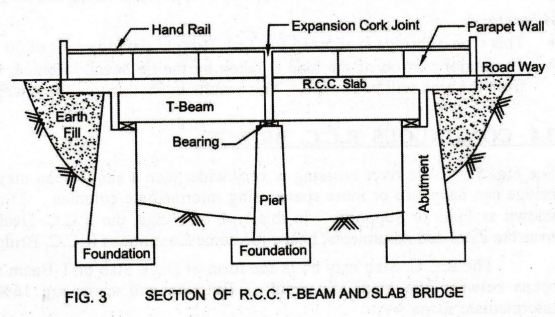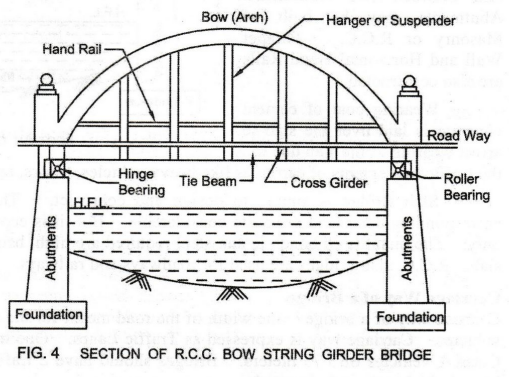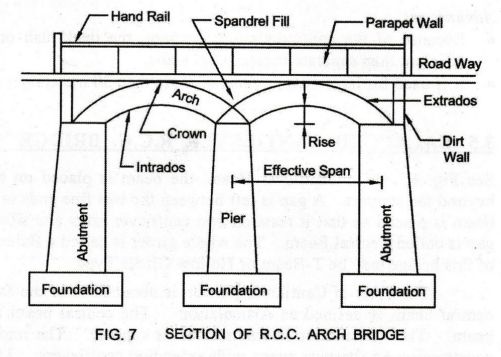Basic Civil & Mechanical Engineering: UNIT III: j. Bridges
R.C.C. bridges
Types, Structural Diagram, Advantages | Civil Engineering
1. R.C.C. slab bridge, 2. R.C.C. t-beam and slab bridge, 3. R.C.C. bow string girder bridge, 4. Continuous R.C.C. bridge, 5. Balanced cantilever R.C.C. bridge, 6. R.C.C. arch bridge, 7. Rigid frame R.C.C. bridge
R.C.C. BRIDGES
1. R.C.C. SLAB BRIDGE
See
Fig. 2. The basic bridge form is a R.C.C. Slab and hence the name R.C.C. Slab
Bridge. It is a single span bridge. The R.C.C. Slab R.C.C. slab of large
thickness is laid between two Abutments. Abutments may be built of Masonry or
R.C.C. Parapet Wall and Horizontal Hand Rails are also constructed.

Wearing
coat of cement concrete is laid over the slab to arrest wearing of the slab due
to the traffic movements of carriages like heavy vehicles, trucks, busses, etc.
Slab
Bridge is simple to design and construct. The thickness of the slab and the
corresponding dead load are quite considerable. But, it is economical up to a
span of 9 meters only. The quantity of concrete and steel required are high,
because of the large thickness of the slab. R.C.C. slab bridges are used for
roadways and railways.
Carriage
Way of a Bridge
Carriage
way of a bridge is the width of the road meant for the movement of carriages
and heavy vehicles. Carriage way is expressed as Traffic Lanes. One traffic
lane represents the width of Class A vehicles of 3.75 meters. Bridges should
have 2 traffic lanes at least or 4 or 6 traffic lanes in highways and city
roads.
2. R.C.C. T-BEAM AND SLAB BRIDGE
See
Fig. 3. In this type, the Beam and R.C.C. Slab are cast monolithically. The
cross-section has the shape of T and hence the name T-Beam and Slab Bridge.

Slab
is supported over T-Beams. T-Beams are simply supported over Piers and
Abutments. Piers and abutments are made of R.C.C.
T-Beams
function as main longitudinal girders. They transmit the load from the slab to
the piers and abutments. The roadway is supported on T-Beams. Wearing Coat of
cement concrete is laid over the slab to arrest the wearing of the slab due to
the traffic movements of heavy vehicles, trucks, buses, etc. The advantages of
R.C.C. T-beam and slab bridge are:
•
This type of bridge is suitable for spans between 9 to 20 meters.
•
It is durable, compact and gives a neat, pleasing and aesthetic appearance.
•
It is cheaper in construction than Steel Bridge.
3. R.C.C. BOW STRING GIRDER BRIDGE
See
Fig. 4. Components of R.C.C. Bow String Girder Bridge are: Arch (Bow), Tie
Beam, Abutments, Hangers, etc. In this, the load carrying structure is known as
Bow String Girder.

Arch
looks like a bow and the horizontal Tie Beam as a string of the bow. Hence, the
name is Bow String Girder Bridge.
Cross
Girders rest on the tie beam and support the Road Way. The beam is suspended
from the arch by Suspenders or Hangers.
In
this bridge, horizontal thrust from the arch is resisted by horizontal tie
beam. The bow is tied horizontally by tie members. Tie beam is supported on
Hinge Bearing at one end to permit rotation. The other end is supported on
Roller Bearing to allow for expansion.
Advantages
•
This type of bridge is adopted for Arch Bridges having spans of 30 to 40
meters.
•
The major portion of the load is taken by the tie beam. Hence, the force on the
abutments from the arch will be limited. This results in abutments of less
weight.
4. CONTINUOUS R.C.C.
BRIDGE
See
Fig. 5.

If
the river crossing is very wide, then a single span may not be economical. The
bridge can have two or more spans using intermediate columns. The intermediate
columns are known as Piers or Supports. In this type of bridge, the R.C.C. Deck
Slab is made continuous over the Piers and Abutments, hence the name Continuous
R.C.C. Bridge.
The
R.C.C. Slab may be in the form of Deck Slab or T-Beam section. The intermediate
spans between the piers are equal. But, the end spans are 16% to 20% lesser
than the intermediate spans.
Advantages
•
Because of the continuous arrangement, the deck slab or t-beam is stronger. efficient
than separate independent slabs.
• It is used for large span lengths of more
than 30 meters. It is more
5. BALANCED CANTILEVER R.C.C. BRIDGE
See
Fig. 6. In a Cantilever Beam, the beam is placed on two piers so that one end
extends beyond the support. A gap is left between the two free ends or
Cantilever Arms. Then, a shorter beam is placed so that it rests on two
cantilever arms and fills the gap. The beam that fills the gap is called
Central Beam. The whole girder is called a Balanced Cantilever. The cross
section of this bridge may be T-Beam or Hollow Girder Type.
The
Span of Cantilever portion is about 25% of the Supported Span. The length of
the central beam is defined as Articulation. The central beam is designed as a
simply supported beam. The Articulation is also treated as support. The
important feature of this bridge is the construction of alternate spans with
extending cantilevers. The ends of the cantilevers are used as supports for the
central beam.

Advantages
•
It can be erected without false work.
•
Providing continuous spans minimizes the bending moments. Therefore, individual
span lengths can be increased. But, this requires unyielding supports. Any
yielding of support results in distress in structure. To avoid this, a
combination of cantilever and suspended spans can be adopted.
•
This type of bridge is suitable for spans in the range of 35 to 70 meters.
•
This type of bridges requires comparatively light piers.
•
This type of dam is preferred in places where small spans are uneconomical.
Also, it can be used in yielding river beds, where foundations are costlier.
6. R.C.C. ARCH BRIDGE
An
Arch is a curved beam carrying loads by simple compression to the strong end supports.
Arch bridges are constructed with R.C.C. or steel.
When
an arch is built of R.C.C., the ends of the arch are prevented from moving outwards
by a concrete tie.
See
Fig. 7. A typical R.C.C. Arch Bridge consists of Arches, Abutments, Piers,
Extrados, Intrados, Spandrel Fill, Dirt Walls, Parapet Wall, Foundation for
piers and abutments, Hand Rail, Road Surface, etc.

The
arches rest on Piers and Abutments. Arch shapes may be Semi-circular,
Elliptical, Parabolic, Segmental, Multi-centered, Pointed, etc. The outer
surface of the arch is known as Extrados. The inner surface of the arch is
known as Intrados. Spandrel Fill is an irregular triangular space as shown.
This type of R.C.C. arch bridge is known as Spandrel-Filled Arch. Road Way with
wearing coat of concrete is constructed on the top of the arches.
Arch
Bridges produce inclined pressures on the supports under vertical loads.
Therefore, they require very strong abutments to withstand the inclined end
reactions. Consequently, they are used only where it is possible to have rigid
foundations.
Advantages
•
R.C.C. Arch Bridges can be used for spans from 20 meters to 250 meters.
•
Arch bridges are graceful with a neat, pleasing, aesthetic and elegant
appearance.
•
They are easy to construct.
•
They are preferred for deep gorges with rocky abutments. Therefore, bending
will not occur in the arch. This results in long life of the bridge.
7. RIGID FRAME R.C.C. BRIDGE
See
Fig. 8. In this type of bridge, R.C.C. Portal Frames
are used for the construction of the bridge. The
substructure of the bridge
including the Abutments and the Deck Slab are monolithically cast. Road way is
laid at the top of the deck slab.

Advantages
•
These
bridges are suitable for a maximum span of 20 meters.
•
They have all the advantages of the Continuous R.C.C. Bridge.
•
Bearings are not needed over the abutments.
•
Abutments are stable. Hence, the bridge has high stability against lateral
forces such as wind and earthquake.
Basic Civil & Mechanical Engineering: UNIT III: j. Bridges : Tag: : Types, Structural Diagram, Advantages | Civil Engineering - R.C.C. bridges
Related Topics
Related Subjects
Basic Civil and Mechanical Engineering
BE3255 2nd Semester 2021 Regulation | 2nd Semester EEE Dept 2021 Regulation
